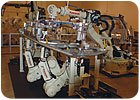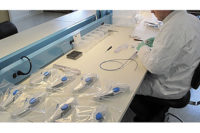Thanks to better designs and controls, robots are being used to hold and position parts for processing by robots and other machines.

When I was a kid, I dreaded Saturdays when my father worked on his jalopy du jour. “I could use an extra pair of hands,” he’d ask cheerfully, but I knew this was doublespeak for “hold a work light for the next several hours and keep quiet.” As my arm grew numb keeping the lamp steady, my mind wandered. “Someday,” I thought. “Robots will do this job, and boys everywhere will be free to play ball with their buddies.”
Decades later, I can report that a young boy’s dream is closer to reality-at least for manufacturers of large assemblies. Until recently, robots have always been used to perform specific processes-welding, dispensing, screwdriving, painting or simply loading and unloading a machine. Now, a growing number of manufacturers are using robots like my father’s proverbial “extra pair of hands.” That is, they are using robots as flexible fixtures to hold and position parts while other robots or machines perform a process.
As with most robotic innovations, the concept was originally developed by the automotive industry. To get lean and better match production to consumer demand, automakers need to produce multiple body styles on the same assembly line. However, hard tooling for each model is expensive. Moreover, swapping out tooling for each variant takes time, and time spent not producing vehicles is waste.
To solve the problem, automakers began experimenting with flexible fixturing. In 1992, for example, Nissan Motor Co. Ltd. (Tokyo) introduced its Intelligent Body Assembly System (IBAS), which can assemble 10 different models at a time in random order. In the IBAS, numerically controlled, servo-driven locators are used throughout the chassis and body assembly lines to position and secure parts for welding. The actuators move to specific locations based on coordinate information transmitted from a computer. The actuators are programmed off-line using simulation software. The system is now in place at Nissan facilities throughout the world, including the company’s plant in Smyrna, TN.
More recently, robot manufacturers have begun offering controllers that allow two robotic arms to work in concert, in the same way that a person uses his two arms. Other suppliers have introduced robots specifically configured for flexible fixturing applications. These robots are driven by the same servomotors, absolute encoders and controllers as six-axis robots, but have shorter, stockier components and fewer axes of motion.
One of those suppliers is Kawasaki Robotics (USA) Inc. (Wixom, MI). Earlier this year, the company unveiled a line of robots, designed specifically for fixturing large parts. Called multiaxis servo positioners, these robots can be equipped with grippers, suction cups, or electric or pneumatic clamps. They can carry payloads of 100 kilograms with a positional repeatability of ±0.05 millimeter.
To demonstrate the capability of the new technology, Kawasaki put together a demonstration cell for spot welding a side panel for a sport utility vehicle. Two fixturing robots (Kawasaki FS20C six-axis robots) were positioned in the middle of the cell, surrounded by four servo locators and flanked on either side by two large six-axis robots. The first six-axis robot picks up a panel with a large gripper constructed from modular aluminum framing. It then positions the panel atop the locators and above the fixturing robots, which reach up to clamp down on specific points. Once the frame is securely positioned, the first six-axis robot moves out of the way, and the second moves in to perform a series of spot welds.
The new robots are already being used at several automotive assembly plants, and the company expects to see the technology expand beyond the automotive industry. “We’re already quoting smaller models for lighter payloads,” says Phil Wright, account manager with Kawasaki.
Like Kawasaki, FANUC Robotics America Inc. (Rochester Hills, MI) has also developed a robot for flexible fixturing. Introduced in June 2007, the F-100iA is a compact, four- or five-axis robot. The first axis is a linear slide with a range of 250 or 500 millimeters, depending on the model. Attached to the slide is a column that can rotate 190 degrees and move up or down 270 millimeters. The wrist can swivel in the horizontal plane, the vertical plane or both. The wrist can be equipped with locating pins, clamps and other devices for holding parts.
The slide enables the robot to move out of the way to allow parts to move into position on a conveyor. Bellows protect both the slide and the vertical axis from weld spatter. One controller can manage six F-100iA units.
Another FANUC robot that can be used for flexible fixturing is the F-200iB. A parallel link, or delta style, robot, the F-200iB consists of six servo-driven ballscrew actuators that connect a base plate measuring 700 millimeters long and 650 millimeters wide to a 475-millimeter-wide faceplate.
Its work envelope is shaped roughly like the bottom half of an inverted cone. The widest part of the cone measures more than a meter in diameter. The narrowest part of the cone is 852 millimeters in diameter. The robot has a vertical reach of 494 millimeters, and a maximum payload of 100 kilograms.
Besides fixturing, the F-200iB can also be used for welding, nutrunning, material removal, dispensing and painting. “The F-200 is very stiff, so it’s ideal for applications like fixturing or routing. A typical six-axis robot or SCARA is not as stiff,” says Mike Sharpe, director of materials joining at FANUC.

The capabilities of fixturing robots are demonstrated in this cell for spot welding a side panel for a sport utility vehicle. Two midsize, six-axis fixturing robots are positioned in the middle of the cell, surrounded by four multiaxis servo locators and flanked by two large six-axis robots. The first large robot (right) picks up a panel and positions it atop the locators and above the fixturing robots, which reach up to grasp it. Once the first large robot moves out of the way, the second (center, in the background) moves in to execute the welds. Photo courtesy Kawasaki Robotics (USA) Inc.
Why It Works
Several technological advancements have come together to make robotic fixturing feasible. For one, the cost of robots has decreased dramatically over the past few years. Suddenly the idea of purchasing several robots simply to hold parts no longer seems extravagant.Another key development is the increasing power of controllers. Kawasaki’s Multi D controller can manage 48 axes of motion, while FANUC’s R30 controller can handle four robots and eight motion groups. Multiple controllers can be tied together across a high-speed network, so an entire assembly line can be managed as if from one controller.
“I can control two arc-welding robots and two handling robots, and I can coordinate their activity with a servo-driven positioner, a conveyor or other motion systems-all from the same controller,” explains Sharpe. “Everything is programmed through the teach pendant, and safety is all interlocked, so you won’t ruin your parts or equipment due to inadvertent operations.”
Wright adds that the concept of robotic fixturing makes sense purely from a financial standpoint. If an automaker has to build five different vehicles, it either has to buy five sets of hard tooling or one set of flexible fixtures. The initial cost of one set of hard tooling might be low, but multiplied by five, the total tab gets large in a hurry. In contrast, the initial cost of flexible fixturing might be high, but that expense gets divided by five.
Flexible fixturing also pays dividends if a part changes. If an assembler uses hard tooling to fixture the parts, it may need to replace some or all of the tooling. If an assembler uses robots, it simply needs to reprogram them. “Think of it as ‘electronic shimming,’” says Wright.

